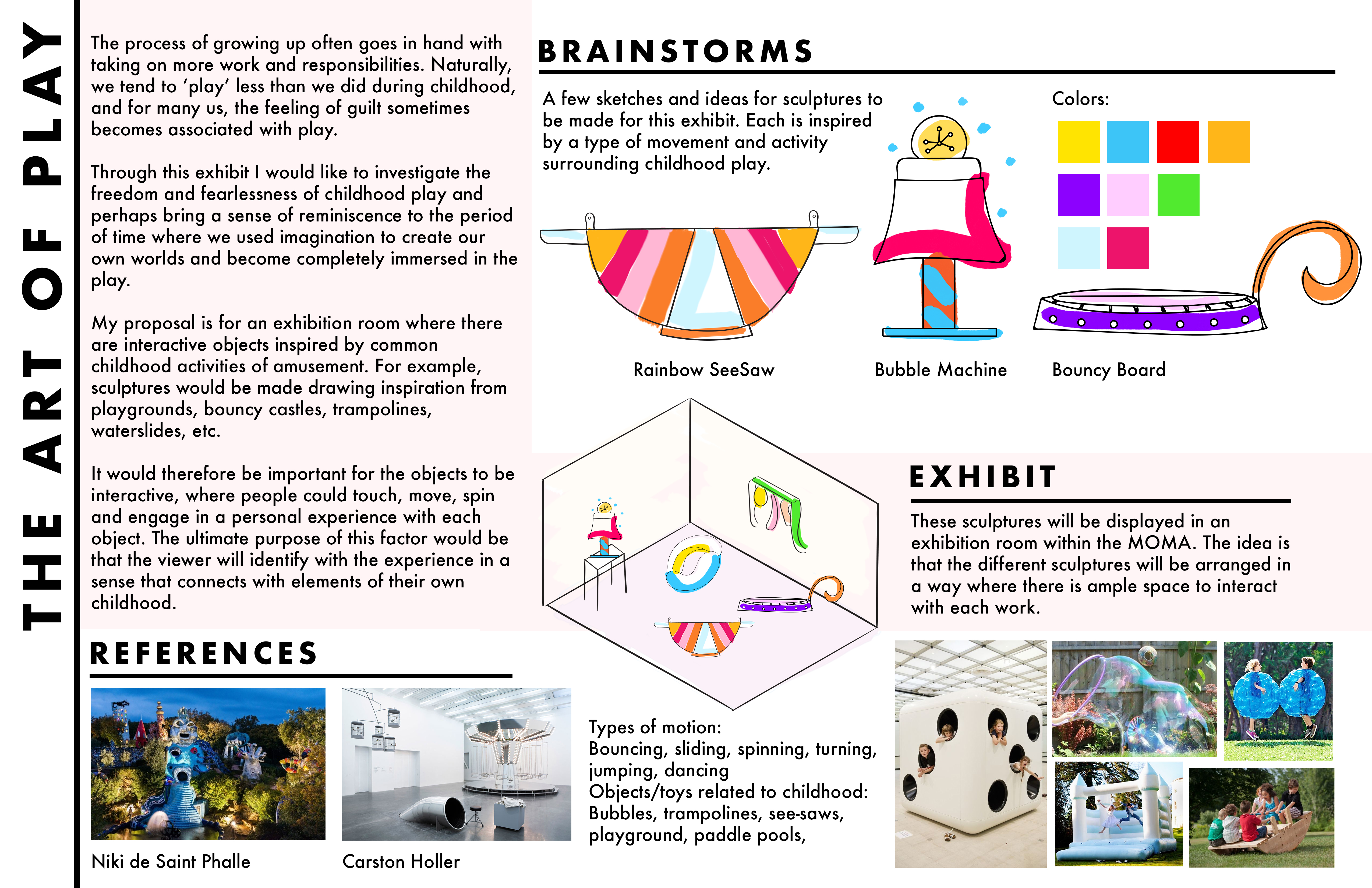The process of growing up often goes in hand with taking on more work and responsibilities. Naturally, we tend to ‘play’ less than we did during childhood, and for many us, the feeling of guilt sometimes becomes associated with play. Of course, what it means to ‘relax’ and ‘play’ changes throughout each stage of life, however, the meaning to take time off and indulge in activities we enjoy stays the same. Through this exhibit I would like to investigate the freedom and fearlessness of childhood play and perhaps bring a sense of reminiscence to the period of time where we used imagination to create our own worlds and become completely immersed in the play.
My proposal is for an exhibition room where there are interactive objects inspired by common childhood activities of amusement. For example, sculptures would be made drawing inspiration from playgrounds, bouncy castles, trampolines, waterslides, etc. It would therefore be important for the objects to be interactive, where people could touch, move, spin and engage in a personal experience with each object. The ultimate purpose of this factor would be that the viewer will identify with the experience in a sense that connects with elements of their own childhood.
It’s also interesting to note that this would be displayed in a museum because of how technology is changing the way that children play. With the advancement of technology, play is becoming increasingly more digital, with numerous amounts of video games, apps, and virtual reality. Playing handball, foursquare, or even running around playing ‘tag’ seems to be now, old fashioned.
My research will be based on the psychology of what it means to play, and children’s relationship to activities and amusement. Design wise, I would research color theories and materials that best suggest these positive connotations. Additionally, I would also like to research the benefits of ‘play,’ which ultimately means to take time off and enjoy an activity. In adult terms, this would commonly be refereed as ‘downtime.’ This is because personally I have experienced stress over going out with my friends or watching a movie because I of the work that hasn’t been completed yet. Consequently, I’m unable to fully enjoy what is supposed to be my idea of having fun and the result would be to become more stressed. It’s interesting how our perspectives towards play changes as we mature.
My next steps would be to conduct my research and interview people about their favorite types of activities as a child and their relationship with those activities and forms of enjoyment now. I believe that the information that I will receive will greatly guide my decisions for this project as well as impact the outcomes in which I will create. I think that not only I will learn a lot about experimenting with different materials, and new ways to express my creativity but also about the societal impact on our psychology in the process of becoming an adult.
Bibliography:
Brene Brown, “Cultivating Play and Rest: Letting Go of Exhaustion as a Status Symbol and Productivity as Self Worth” in The Gifts of Imperfection. Minnesota: Hazelden Publishing, 2010.
Heaney, Kate. “How to Be Lazy” last modified March 6, 2018.
https://www.thecut.com/2018/03/how-to-relax.html
Gleason, Tracy. “Why make-believe play is an important part of childhood development” last modified April 6, 2016.
http://theconversation.com/why-make-believe-play-is-an-important-part-of-childhood-development-49693
Trafton, Anne. “The relationship between child’s play and scientific exploration,” MIT News Office.
http://news.mit.edu/2013/laura-schulz-profile-0214
Clotti, Gregory. “The Psychology of Color in Marketing and Branding” last modified April 13, 2016.
https://www.entrepreneur.com/article/233843
Kirkwood, Scott. “Take Back Your Weekends (and Leave the Work at Work)” 99U.
http://99u.adobe.com/articles/55585/take-back-your-weekends-and-leave-the-work-at-work
SaveSave
SaveSave
SaveSave
SaveSave


